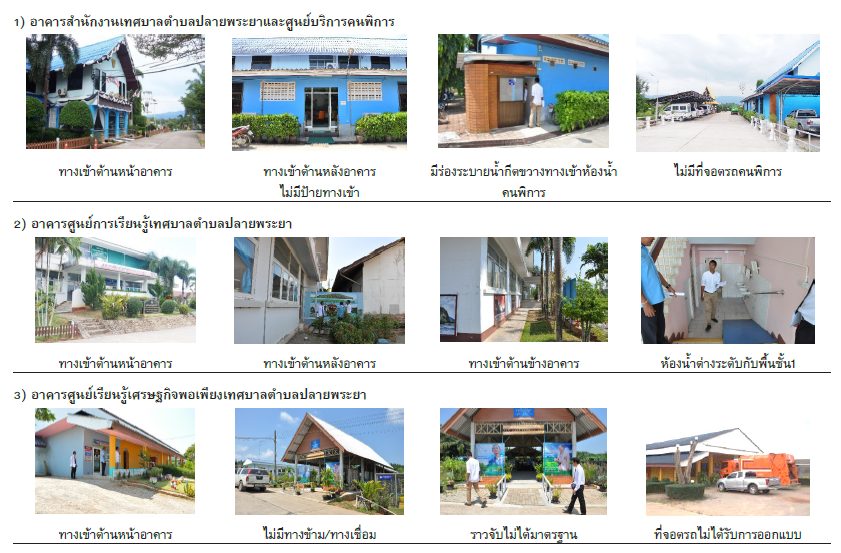Design Guidelines of Physical and Facilities Improvement for All: A Case Study of Plai Phraya Sub-district Municipality, Krabi
Main Article Content
Abstract
The government has a policy for Krabi Province to be a pilot area for the community building project of coexistence. The Office of Social Development and Human Security selected Plai Phraya Sub-District Municipality, Krabi province based on its potential for improvement. The purpose of this project is to empower the people in the community, especially the disabled and the elderly through the implementation of facilities that are accessible and can support a wide variety of needs. This research aims to study the current physical environment in the government area of Plai Phraya Sub-district Municipality Krabi province and suitable and appropriate design ideas for the people of the government area as well as propose guidelines for improving the design. Tools used in the research were site observation for evaluating the physical environment and facilities for the elderly, the disabled, and the general population in the area. Semi-structural interviews were conducted along with non-participatory observation about attitudes and behavior of citizens and government officials according to the Universal Design concept. The collection of physical data was performed by taking photos and surveying and the results revealed that there are facilities for the elderly and people in Plai Phraya Subdistrict Municipality Office Building and the Public Service Center Building. There are, however, key factors to take into consideration. Firstly, their numbers are lower than the minimum requirements by the ministerial regulation, and, secondly, there is a lack of understanding amongst the citizens which impedes the progression of the development and improvement of the area. The research concludes that the environment and facilities must be designed to be equitable, comfortable, secure, independent, comfortable, and private. In this case, there are limitations of the original building and location conditions which will be a difficult design hurdle to overcome. However, corporate culture characteristics may prove useful in reducing this obstacle.
Downloads
Article Details

This work is licensed under a Creative Commons Attribution-NonCommercial-NoDerivatives 4.0 International License.
All material is licensed under the terms of the Creative Commons Attribution 4.0 International (CC-BY-NC-ND 4.0) License, unless otherwise stated. As such, authors are free to share, copy, and redistribute the material in any medium or format. The authors must give appropriate credit, provide a link to the license, and indicate if changes were made. The authors may do so in any reasonable manner, but not in any way that suggests the licensor endorses you or your use. The authors may not use the material for commercial purposes. If the authors remix, transform, or build upon the material, they may not distribute the modified material, unless permission is obtained from JARS. Final, accepted versions of the paper may be posted on third party repositories, provided appropriate acknowledgement to the original source is clearly noted.
References
Plaiphaya Multicipality Krabi, Section of Plan and Policy Analysis. (2020). Plai Phraya district development plan for three years 2016 - 2018. Retrieved from http://www.plaiphraya.com/panpattana.html.
Plaiphaya Multicipality Krabi, Division of Social Welfare. (2019). Analysis and summary of Krabi situation with policy recommendations. Retrieved from http://krabi.thailocallink.com/files/com_news_gis/2021-02_6aa1ac24e539291.pdf
Ronald L. Mace. (2008). The Center for Universal Design Environments and Projects for All People: About the Center: Ranald L. Mace. Retrieved from https://projects.ncsu.edu/ncsu/design/cud/about_us/usronmace.htm
The National Institute on Disability and Rehabilitation Research, U.S. Department of Education, 1997. Thairath, C. (2019). Designing a Vibrant Community for the Elderly For rural elderly. Retrieved from https://kpi.msu.ac.th/upload/ag_tor_ref_byval/ag_12_in_3.1.4_38.doc.
Association of Siamese Architects Under Royal Patronage. (2009). Universal design code of practice. Bangkok: Plus Press.
Ministerial regulation prescribing building. (2005). Facilities for the disabled or handicapped and the elderly, 2005: Government Gazette, Volume 122 (2 July 2005).
Pornwitu, K. (2014). Universal Design [Online]. Office of Academic Affairs Secretary-General of the Senate, 4(21), 4-26.


